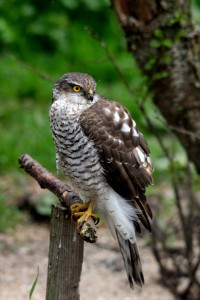 For people who regularly put food out for birds at feeding stations in the garden there are always problems. Two of the main ones are domestic cats and sparrowhawks with, arguably, the main one of these two being cats. Cats seem to be a law unto themselves as so many are just let out, sometimes specifically at night, and they do untold damage to birds and small mammals. The problems with these two predators is so paramount in many peoples’ eyes that the British Trust for Ornithology have even issued special leaflets on both of them. Many sources give some astonishing figures for the numbers of prey that the cats kill annually but the most reliable source appears to be the BTO. In their leaflet they indicate that studies suggest 275 million animal deaths every year in the UK can be put down to cats.
For people who regularly put food out for birds at feeding stations in the garden there are always problems. Two of the main ones are domestic cats and sparrowhawks with, arguably, the main one of these two being cats. Cats seem to be a law unto themselves as so many are just let out, sometimes specifically at night, and they do untold damage to birds and small mammals. The problems with these two predators is so paramount in many peoples’ eyes that the British Trust for Ornithology have even issued special leaflets on both of them. Many sources give some astonishing figures for the numbers of prey that the cats kill annually but the most reliable source appears to be the BTO. In their leaflet they indicate that studies suggest 275 million animal deaths every year in the UK can be put down to cats.
These include small mammals, reptiles, amphibians, butterflies and birds. I would add bats to this list as cats seem to find bats increasingly attractive to catch as they swoop out of their roost from under the eaves of houses. The BTO suggests some 55 million birds are killed very year by cats in the UK. Predation of birds is at its peak during the next few weeks when there are many juvenile birds around who are inexperienced. The BTO suggest that cat activity should be curtailed in the next few weeks. Bells fitted to collars to warn birds and mammals can work but apparently the wise cats get used to them and deliberately stalk their prey very slowly so the bells do not sound. Bells also get muffled with age and need replacing. Having at one time kept no less than five cats we never found it necessary to let them out and they lived indoors quite happily to a ripe old age.
Sparrowhawks are almost as evocative as cats and having experienced them in my garden for many years I know they can be frustrating. However, studies show that in overall terms the numbers of birds taken do not affect the population. Many of the bird are not 100% fit and would die anyway for other reasons. This is very little compensation to people who see them suddenly swoop into the feeding station and take small birds. To see the sparrowhawk then perch on a garden fence in full view and pluck a siskin or greenfinch is, naturally , very upsetting. From a sparrowhawk’s point of view we are just providing a picnic table for it to raid at will. The BTO leaflet suggest there are one or two moves we could take in the garden. For example sparrowhawks rely on the element of surprise to gain an advantage over the small birds on which they prey. They will follow the same route through a garden using the cover of a hedge or shed to gain advantage. Whilst you cannot readily move the hedge or shed you could move the feeding station round. Then put the feeders close to dense cover so that small birds can easily fly into to escape the bird of prey.
At the beginning of this past winter I put out a small perch under one of my feeding stations just to photograph small birds, such as bramblings and siskins. The other morning there was a sparrowhawk sat there. At first it fooled me as the colour of its plumage seemed all wrong. The size and colour, including the bright yellow eyes, gave it away as a male from last year. Unfortunely both leaflets, on cats and sparrowhawks, are no longer available from the BTO although there is advice in various books on feeding birds in gardens.
